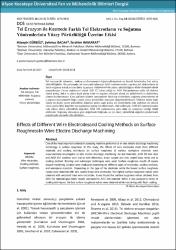| dc.contributor.author | GÜRBÜZ; Hüseyin; BADAY, Şehmus; HAMARAT, İbrahim | |
| dc.date.accessioned | 2019-01-16T08:03:21Z | |
| dc.date.available | 2019-01-16T08:03:21Z | |
| dc.date.issued | 2018 | |
| dc.identifier.uri | http://fenbildergi.aku.edu.tr/wp-content/uploads/2018/09/015901-676-683.pdf | |
| dc.identifier.uri | http://hdl.handle.net/11630/5114 | |
| dc.description | One of the most important criteria in assessing machine performance in wire electro discharge machining
technology is surface roughness. In this study, the effects of wire electrodes made from different
materials and cooling techniques on surface roughness of various workpiece materials were
experimentally investigated in wire electro discharge machining. As test materials, AISI D2 tool steel
and AISI 304 stainless steel and as wire electrodes, brass, copper and zinc coated brass wires and as
cooling method, flushing and submerged techniques were used. Surface roughness results of square
shaped machining samples were evaluated depending on different types of electrodes, cooling methods,
and workpiece materials. Depending on the type of the electrode, while the lowest surface roughness
values were obtained with zinc coated brass wire electrodes, the highest surface roughness values were
obtained with uncoated brass wire electrodes. It was found that surface roughness values obtained from
AISI D2 material gave better results compared to AISI 304 material. When it was assessed in terms of
cooling techniques, the best surface roughness values were obtained while machining with flush cooling. | en_US |
| dc.description.abstract | Tel erozyon ile işlemede, makine performansının değerlendirmesinde en önemli kriterlerden biri yüzey
pürüzlülüğüdür. Bu çalışmada, tel erozyonla işlemede farklı malzemelerden yapılmış tel elektrotların ve
farklı soğutma tekniklerinin farklı iş parçası malzemelerinin yüzey pürüzlülüğüne etkisi deneysel olarak
araştırılmıştır. Deney malzemesi olarak AISI D2 takım çeliği ve AISI 304 paslanmaz çelik, tel elektrot
olarak pirinç, bakır ve çinko kaplı pirinç teller ve soğutma yöntemi olarak ise püskürtmeli ve daldırılmış
yöntem kullanılmıştır. Kare şeklinde işlenen numunelerin farklı tip elektrotlara, soğutma yöntemlerine ve
iş parçası malzemesine bağlı olarak yüzey pürüzlülük sonuçları değerlendirilmiştir. Elektrot tipine bağlı
olarak en düşük yüzey pürüzlülük değerleri çinko kaplı pirinç tel elektrotlarla elde edilirken en yüksek
yüzey pürüzlülük değerleri ise kaplamasız pirinç tel elektrotlarla elde edilmiştir. AISI D2 malzemesinden
elde edilen yüzey pürüzlülük değerleri AISI 304 malzemesine göre daha iyi sonuçlara verdiği tespit
edilmiştir. Soğutma yöntemine göre değerlendirildiğinde, en iyi yüzey pürüzlülük değerleri püskürtmeli
soğutmayla işlemede elde edilmiştir. | en_US |
| dc.language.iso | tur | en_US |
| dc.identifier.doi | 10.5578/fmbd.66968 | en_US |
| dc.rights | info:eu-repo/semantics/openAccess | en_US |
| dc.subject | Tel erozyon; Tel elektrotlar; Soğutma yöntemi; Yüzey pürüzlülüğü. | en_US |
| dc.title | Tel Erozyon ile Kesmede Farklı Tel Elektrotların ve Soğutma Yöntemlerinin Yüzey Pürüzlülüğü Üzerine Etkisi | en_US |
| dc.title.alternative | Effects of Different Wire Electrodesand Cooling Methods on Surface RoughnessIn Wire Electro Discharge Machining | en_US |
| dc.type | article | en_US |
| dc.relation.journal | Fen ve Mühendislik Bilimleri Dergisi | en_US |
| dc.department | Afyon Kocatepe Üniversitesi | en_US |
| dc.identifier.volume | 18 | en_US |
| dc.identifier.startpage | 676 | en_US |
| dc.identifier.endpage | 683 | en_US |
| dc.identifier.issue | 2 | en_US |
| dc.relation.publicationcategory | Makale - Ulusal Hakemli Dergi - Kurum Yayını | en_US |



















